Dust collectors play a crucial role in maintaining air quality in various industrial settings. By effectively capturing and filtering airborne particles, they not only protect workers’ health but also contribute to broader environmental sustainability. As industries increasingly recognize the importance of minimizing their ecological footprint, understanding the environmental impact of dust collectors becomes essential.
Importance of Dust Collection Systems
Dust generation is a common challenge in industries such as woodworking, metalworking, pharmaceuticals, and food processing. Uncontrolled dust can lead to respiratory problems, reduced visibility, and even fire hazards. Furthermore, dust particles can settle on machinery and products, leading to quality issues and increased maintenance costs. Dust collectors address these challenges by capturing particulate matter before it can enter the atmosphere.

Mechanisms of Dust Collection
Dust collectors operate through various mechanisms, including bag filters, cyclone separators, and electrostatic precipitators. Bag filters use fabric to trap particles, while cyclone separators leverage centrifugal force to remove larger particles. Electrostatic precipitators use electric fields to charge particles, causing them to adhere to collecting plates. Each system has its advantages and is selected based on the specific needs of the operation, including the type and size of dust produced and how does osha enforce its standards.
Environmental Benefits
Reduction of Airborne Particles – By capturing dust, these systems significantly reduce the concentration of airborne particulate matter. This has a direct impact on air quality, leading to healthier environments for workers and surrounding communities.
Compliance with Regulations – Many industries are subject to environmental regulations that limit the emission of particulate matter. Dust collectors help businesses comply with these regulations, avoiding penalties and promoting sustainable practices.
Minimization of Waste – In addition to capturing harmful dust, many dust collectors also allow for the recovery of valuable materials. For instance, in woodworking, collected sawdust can be repurposed for energy production or used in the manufacturing of composite materials. This not only reduces waste but also supports a circular economy.
Decreased Energy Consumption – Effective dust collection systems can enhance the efficiency of industrial processes. By preventing dust buildup on machinery, these systems reduce the energy required for operations, leading to lower overall energy consumption and greenhouse gas emissions.
Challenges and Considerations
While dust collectors offer numerous environmental benefits, they are not without challenges. Maintenance is essential to ensure optimal performance clogged filters can lead to reduced efficiency and increased emissions. Moreover, the energy consumption of dust collection systems must be considered. Designing systems that balance energy use with dust capture efficiency is critical for maximizing their environmental benefits.
Future Trends
As technology advances, the dust collection industry is evolving. Innovations in filtration materials, automation, and monitoring systems are enhancing the efficiency and effectiveness of dust collectors. Furthermore, the integration of smart technologies allows for real-time monitoring and predictive maintenance, ensuring that systems operate at peak performance while minimizing energy use and visit now www.tysum.com.
Dust collectors play a vital role in reducing airborne particles and improving air quality in industrial settings. By capturing harmful dust, these systems protect both worker health and the environment, enabling industries to operate sustainably. As businesses continue to prioritize eco-friendly practices, the importance of effective dust collection systems will only grow, paving the way for cleaner, safer industrial operations. Embracing these technologies not only enhances compliance with environmental regulations but also supports the broader goal of sustainability in the industrial sector.
